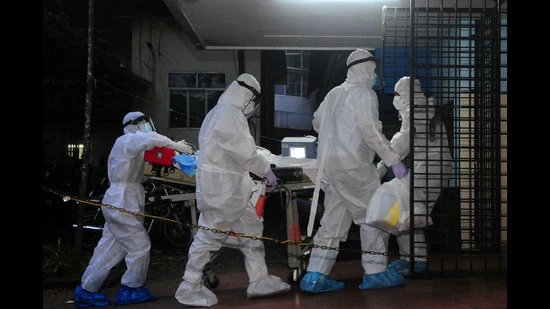The health officials in Kerala have strengthened ward-level surveillance for people suffering from fever and intensified the tracing of contacts by scanning CCTV cameras and hospital outpatient registers after a second Nipah death in the last two weeks, officials familiar with the matter said.
Kerala, which first reported Nipah outbreak in 2018, has recorded four cases this year so far, of which two have died, one recovered and the other is undergoing treatment.
The latest death was that of a 57-year-old man, a resident of Kumaramputhur near Mannarkkad in Palakkad district, at a private hospital in Perinthalmanna on July 12. He was tested positive on Sunday night, propelling officials to reinforce Nipah protocols again and initiate contact-tracing measures.
A total of 609 people who came into contact with Nipah infected patients have been traced by preparing a “route map,” and accordingly, fever surveillance has been intensified, health minister Veena George said on Monday.
A district health official in Palakkad, who asked not to be identified, said 112 people who had primary or secondary contact with the deceased have been identified so far. “His death is being treated as a fresh case because he had no contact with the earlier Nipah cases reported in the last two months. The 57-year-old began experiencing symptoms, especially fever, on July 6 and we have found that he visited at least three clinics and tertiary hospitals before seeking treatment at the private hospital where he eventually died. We have published a route map of all the places he had visited with the timeline and we are getting a lot of calls in the control room.”
“With the help of CCTV cameras in places he visited and the outpatient registers of the hospitals he went to, we have compiled a list. Those persons are being put under quarantine. The municipal ward where the deceased’s home is located has been declared a containment zone. Fever surveillance has begun in the area,” she said.
The 57-year-old was contacted by the Nipah controlroom officials after he reported fever-like symptoms in the days leading up to his death. “Calls were made to him on July 8, 9 and 10. But he couldn’t be contacted after that. His symptoms deteriorated quite fast resulting in his death,” the official said.
She said that officials at the local level are attempting to find out how the 57-year-old contracted Nipah in the first place. The virus is mainly transmitted by fruit bats and the spillover to humans occur through contact with bat secretions like urine, saliva and faeces or through contaminated fruit sources which may be bitten by bats. “There are reports that he ate a piece of jackfruit that had fallen on the ground while visiting his plantation in Agali on June 30. The jackfruit might have been bitten by bats. There is no concrete evidence yet,” she said.
R Renuka, Malappuram district medical officer (DMO), said the routine scanning for Acute Encephalitis Syndrome (AES) and Acute Respiratory Distress Syndrome (ARDS) cases at all hospitals in the district have been helpful in detecting Nipah infections. Malappuram is one of the six districts where an alert has been issued by health officials in the wake of Nipah cases. An 18-year-old woman from Malappuram was the first who was tested Nipah positive and died this month.
“We have been looking out for AES and ARDS cases for quite some time. Instructions have been given to all hospitals to look at the viral panel in these cases. Apart from Nipah, it could be influenza or H1N1 cases as well. Since this period is particularly a breeding season of the bats, we have been taking more care,” she said.
